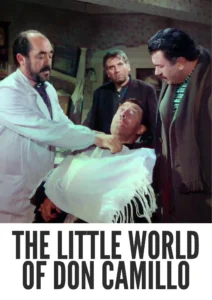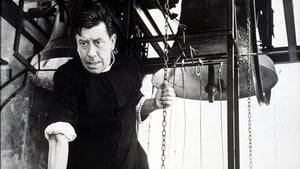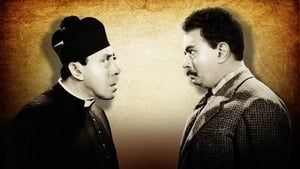Contact: info@alwanfilm.com
Video Sources 0 Views

Synopsis
Review: The Little World of Don Camillo 1952 Colorized – A Heartfelt Exploration of Faith, Humor, and Humanity

Introduction
In the pantheon of classic cinema, “The Little World of Don Camillo” (1952) occupies a special place as a film that masterfully blends humor, warmth, and socio-political commentary. Directed by the Italian filmmaker Julien Duvivier, this beloved film is based on the stories by Giovanni Guareschi and is a quintessential representation of post-war Italian cinema. The film’s recent re-release in a colorized version has sparked fresh interest and debate among audiences, providing an opportunity to re-examine its impact and relevance. In this article, we will delve into the enduring appeal of “The Little World of Don Camillo,” the significance of its early colored version, and its place in the history of cinema.
Check The Full Colorized Movies List
Check Our Colorized Movies Trailer Channel
Understanding The Little World of Don Camillo 1952 Colorized: Director, Cast, and Genre
“The Little World of Don Camillo” was brought to life by the skilled direction of Julien Duvivier, a filmmaker known for his versatility and command of various genres. Duvivier’s direction shines in this film, where he skillfully balances comedy and drama, crafting a narrative that is both deeply human and universally relatable.
The film stars the iconic French actor Fernandel in the role of Don Camillo, a fiery and devout Catholic priest with a strong moral compass and an even stronger sense of humor. Opposite him is Gino Cervi, who plays Peppone, the communist mayor of a small Italian village. Their on-screen chemistry and comedic timing form the backbone of the film, making their rivalry both amusing and endearing.
“The Little World of Don Camillo” is a charming comedy-drama that reflects the complexities of post-war Italian society. Its genre can be seen as a blend of satire, comedy, and slice-of-life drama, as it navigates the tensions and camaraderie between two ideological opponents who are, at heart, devoted to the welfare of their community.
Exploring the World of The Little World of Don Camillo: Plot and Characters
At its heart, “The Little World of Don Camillo” is a story about the clash and eventual understanding between two strong-willed individuals: Don Camillo, the parish priest, and Peppone, the communist mayor. The film is set in a small, picturesque village in the Po Valley of Italy, where the two characters, despite their fierce ideological differences, share a common love for their town and its inhabitants.
The plot revolves around the humorous and often poignant confrontations between Don Camillo and Peppone, as they navigate the challenges of leading a community in the aftermath of World War II. The film is divided into a series of vignettes that highlight key moments in their ongoing feud, which is as much about their political differences as it is about their deep-seated friendship and mutual respect.
Don Camillo is a character full of contradictions. He is a man of God with a fiery temper, known for his physical strength and his direct, sometimes combative, approach to solving problems. Yet, he is also deeply compassionate, and his conversations with Christ (represented by a crucifix in his church) reveal his inner struggles and desire to do what is right.
Peppone, on the other hand, is a devoted communist who genuinely believes in the principles of his party. However, his practical and often paternal approach to leadership shows that he is more concerned with the well-being of his townspeople than with strict ideological adherence. His interactions with Don Camillo often bring out the best in him, as their rivalry pushes both men to rise above their differences for the greater good.
The Art of Film Colorization
Film colorization, the process of adding color to black-and-white footage, has been a controversial yet fascinating aspect of cinema for decades. The goal of colorization is often to attract new audiences to classic films, making them more accessible to those who might be put off by black-and-white imagery. However, the process itself is complex and requires a deep understanding of the original film’s visual tone and thematic content.
Colorization involves using digital technology to add layers of color to the original black-and-white film. This process is not merely about adding color but about interpreting the light, shadow, and textures that were initially intended to be viewed in monochrome. The result can bring a new dimension to the film, allowing modern audiences to see details and nuances that might have been overlooked.
Early Colored Films: A Brief History
The history of colorization dates back to the early days of cinema, with filmmakers experimenting with hand-painted frames and tinting techniques. As technology advanced, so did the methods of adding color to films, culminating in the development of Technicolor in the 1930s. This revolutionized the industry, allowing for the production of vibrant, full-color films that captivated audiences.
However, colorization as we know it today—applying color to films that were originally shot in black and white—began in the 1980s. This practice has been met with both enthusiasm and criticism, as it raises questions about the preservation of the original artistic vision versus the potential for broader audience engagement.
The Little World of Don Camillo 1952 Colorized and Its Early Colored Version
The decision to release a colorized version of “The Little World of Don Camillo” is both an homage to the film’s enduring popularity and an attempt to introduce it to a new generation of viewers. The early colored version offers a fresh perspective on the familiar story, highlighting the lush Italian countryside and the vibrant life of the village in a way that black and white could only suggest.
In the colorized version, the small village of Brescello, where the film was shot, comes to life with a new vibrancy. The warm tones of the buildings, the rich greens of the surrounding fields, and the colorful clothing of the villagers all add a layer of immediacy and relatability to the story. While the original black-and-white version has its own charm, the colorized version enhances the film’s nostalgic appeal and makes the setting feel more tangible.
The Debate Over Film Colorization
The debate over film colorization is a longstanding one, with passionate arguments on both sides. Purists argue that colorizing black-and-white films is a form of artistic vandalism, altering the original vision of the filmmakers who carefully crafted their movies within the constraints and possibilities of monochrome photography. They contend that black and white is not merely a lack of color but a deliberate aesthetic choice that conveys mood, tone, and emotion in ways that color can sometimes undermine.
On the other hand, supporters of colorization argue that it brings classic films to a wider audience, making them more accessible to viewers who might be less inclined to watch black-and-white movies. They believe that colorization can help preserve the cultural relevance of older films by making them feel more contemporary and relatable.
“The Little World of Don Camillo” is a prime example of this debate. While some viewers appreciate the added warmth and realism of the colorized version, others feel that the original black and white better captures the film’s timeless, universal themes.
Examining The Little World of Don Camillo 1952 as an Early Colored Film
Examining “The Little World of Don Camillo” through the lens of its early colored version offers insights into both the film’s narrative and its visual storytelling. In black and white, the film emphasizes the stark contrasts between Don Camillo and Peppone, both in terms of their personalities and the ideologies they represent. The monochrome palette lends a sense of gravitas and timelessness to their confrontations, underscoring the universal nature of their struggles.
In the colorized version, these contrasts are softened by the warm, earthy tones of the village and the surrounding countryside. The color palette emphasizes the shared humanity of the characters, highlighting the beauty of the world they inhabit and the common ground they ultimately find. The colorization also brings out details that might have been missed in the original, such as the rich textures of the villagers’ clothing and the vibrant natural environment.
However, the colorized version also alters the film’s visual dynamics in subtle ways. The heightened realism of the color may shift the focus from the symbolic and allegorical aspects of the story to the more immediate, everyday concerns of the characters. This change in emphasis could potentially dilute the film’s satirical edge and its commentary on the socio-political climate of post-war Italy.
Influence and Legacy: The Little World of Don Camillo 1952 Colorized’s Impact on Cinema
“The Little World of Don Camillo” has had a lasting impact on cinema, particularly in the realm of Italian comedy. The film’s blend of humor, heart, and social commentary set a precedent for future films that sought to explore the complexities of life in small communities. Its success also led to several sequels, further cementing the characters of Don Camillo and Peppone in the popular imagination.
The film’s influence extends beyond Italy, resonating with audiences worldwide. Its themes of faith, politics, and community are universal, and its portrayal of the often humorous tension between different belief systems remains relevant today. The characters of Don Camillo and Peppone have become cultural icons, representing the possibility of reconciliation and mutual respect even in the face of deep ideological divides.
Director’s Cinematic Legacy: Beyond The Little World of Don Camillo
Julien Duvivier’s legacy as a filmmaker is richly illustrated by his work on “The Little World of Don Camillo,” but his influence extends far beyond this single film. Duvivier was a master of multiple genres, from crime thrillers to romantic dramas, and his ability to capture the nuances of human emotion and social interaction is evident in all his films.
Before directing “The Little World of Don Camillo,” Duvivier had already established himself as one of the leading figures in French cinema with films like “Pépé le Moko” (1937), which became a cornerstone of the poetic realism movement. His work is characterized by its psychological depth, sophisticated storytelling, and a keen understanding of the human condition.
Duvivier’s impact on both French and international cinema is undeniable. His films have influenced a generation of filmmakers and continue to be studied for their narrative complexity and visual style. “The Little World of Don Camillo” remains one of his most beloved works, a testament to his ability to blend humor with deeper social and political insights.
Themes Explored in The Little World of Don Camillo 1952 Colorized
“The Little World of Don Camillo” explores a variety of themes that are as relevant today as they were in the 1950s. At the forefront is the theme of ideological conflict, represented by the ongoing rivalry between Don Camillo, the Catholic priest, and Peppone, the communist mayor. The film deftly handles this theme with humor and compassion, showing that even the most deeply held beliefs can coexist with mutual respect and understanding.
Another key theme is the role of faith in everyday life. Don Camillo’s relationship with God, as portrayed through his frequent conversations with Christ on the crucifix, highlights the personal nature of faith and its influence on his actions. This theme is presented not with solemnity but with warmth and humor, making it accessible to a wide audience.
Community and the importance of solidarity are also central to the film’s narrative. Despite their differences, Don Camillo and Peppone both care deeply about their village and its inhabitants. Their conflicts, while often heated, ultimately stem from a shared desire to do what is best for their community.
Reception and Controversy Surrounding The Little World of Don Camillo 1952 Colorized
Upon its release in 1952, “The Little World of Don Camillo” was met with widespread acclaim for its humor, charm, and insightful commentary on post-war society. Critics praised Fernandel’s performance as Don Camillo, noting his ability to convey both the character’s strength and his vulnerability. The film’s portrayal of the rivalry between Don Camillo and Peppone resonated with audiences, who appreciated its lighthearted yet thoughtful exploration of serious issues.
The release of the colorized version, however, has been more divisive. While some viewers enjoy the added vibrancy and feel that it brings a new dimension to the film, others argue that the colorization detracts from the original’s aesthetic and tone. The debate over the merits of colorization versus the preservation of the original black and white version continues to be a topic of discussion among fans and film historians alike.
Where to Watch The Little World of Don Camillo 1952 Colorized Online
For those interested in experiencing “The Little World of Don Camillo,” the film is available on several streaming platforms, both in its original black-and-white version and the colorized edition. Major services such as Amazon Prime Video, Criterion Channel, and YouTube often carry the film, making it accessible to a global audience. Whether you prefer the original or the colorized version, the film remains a timeless classic that is well worth watching.
FAQs About The Little World of Don Camillo 1952 Colorized
Q: What is the significance of the film’s title?
A: The title “The Little World of Don Camillo” reflects the close-knit community of the small Italian village where the story takes place. It emphasizes the microcosm of village life, where the conflicts and resolutions of the larger world are played out on a smaller, more personal scale.
Q: How faithful is the film to Giovanni Guareschi’s original stories?
A: The film stays true to the spirit of Guareschi’s stories, capturing the humor, warmth, and social commentary that made the original tales so popular. While some details were adjusted for the screen, the central characters and themes remain intact.
Q: What role does faith play in the film?
A: Faith is a central theme in “The Little World of Don Camillo,” particularly in the life of the titular character. Don Camillo’s conversations with Christ, as depicted on the church’s crucifix, offer insights into his moral struggles and guide his actions throughout the film.
Conclusion
“The Little World of Don Camillo” is a film that has stood the test of time, continuing to charm audiences with its blend of humor, warmth, and social commentary. Whether viewed in its original black and white or the newly colorized version, the film remains a delightful exploration of the human condition, highlighting the importance of community, faith, and understanding. As we continue to revisit and reinterpret classic films like “The Little World of Don Camillo,” it is essential to appreciate both their historical significance and their enduring relevance. The ongoing debate over film colorization only underscores the timeless appeal of these cinematic treasures, inviting new generations to discover the joy and wisdom of Don Camillo’s little world.













